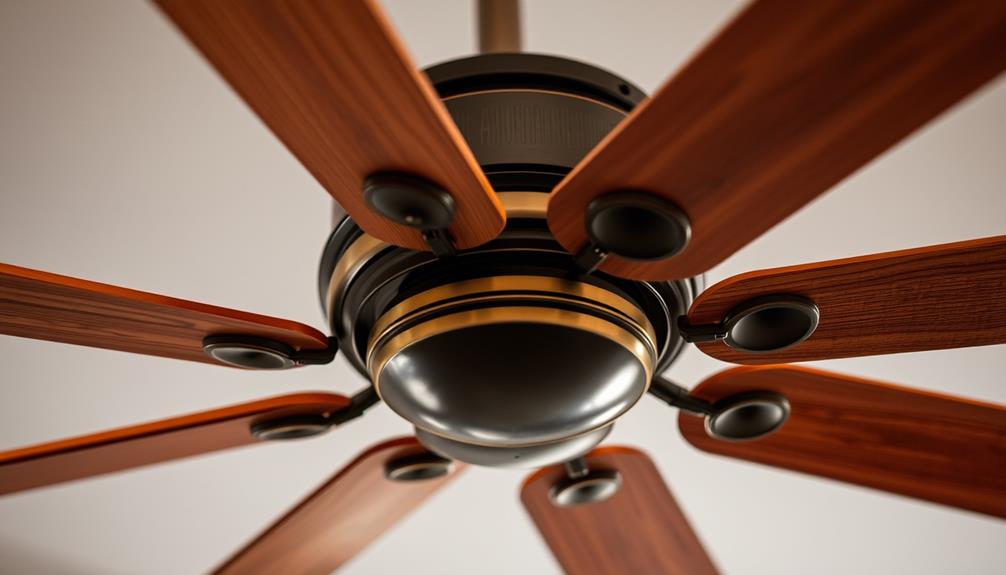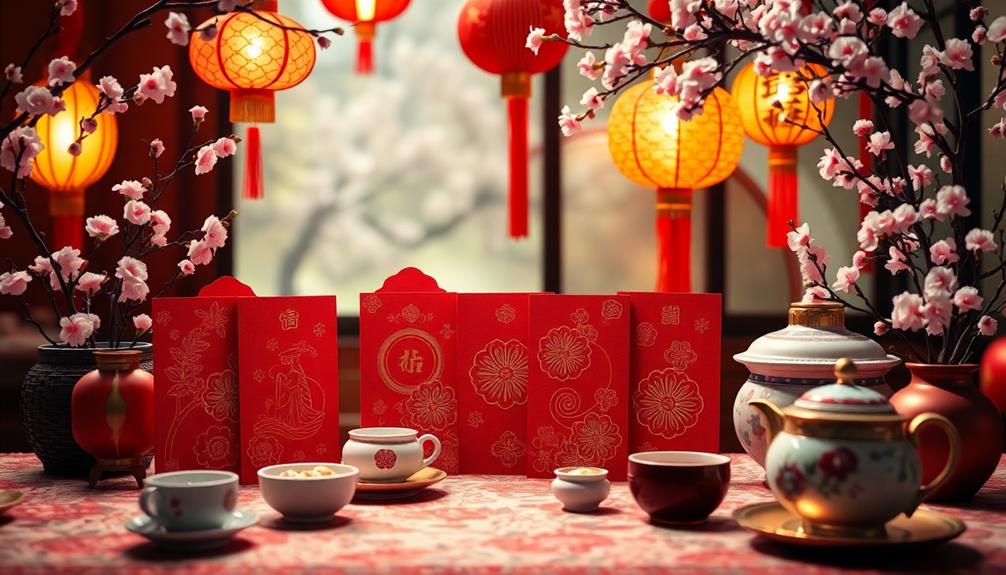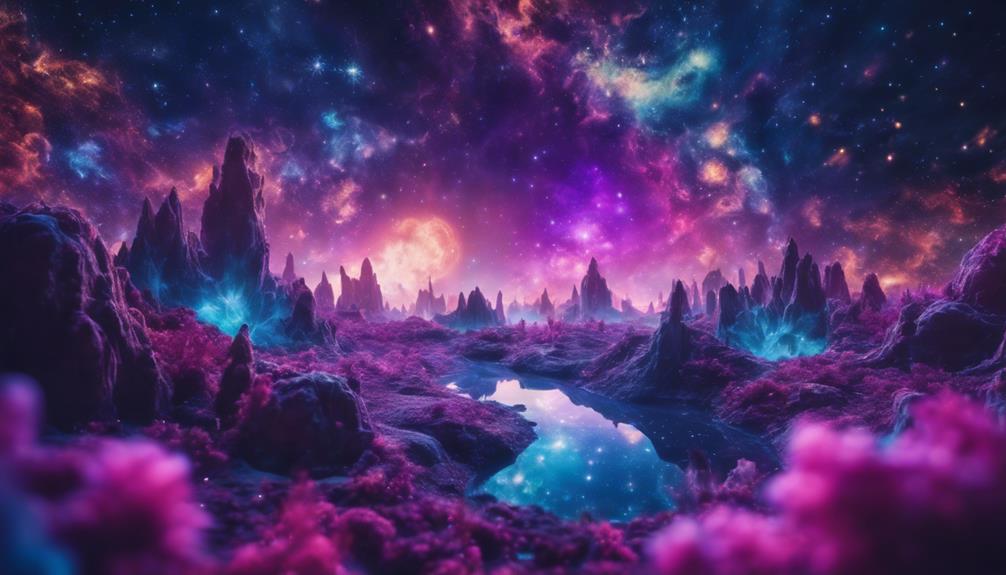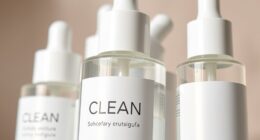Exploring the mysteries of ceiling fan blades can significantly enhance your comfort at home. Initially, it is crucial to grasp their core purpose: circulating air to create a cooling effect. The size, shape, and angle of the blades all play a role in determining how efficiently they move air. Larger blades are able to push more air, while a pitch ranging from 10 to 15 degrees boosts effectiveness. Additionally, the material of the blades is important; wood adds charm but may be prone to warping, whereas metal ensures longevity. Engaging in regular upkeep such as dusting and inspecting for any damages is key to keeping your fan operating smoothly. Lastly, think about upgrading your blades to optimize airflow. The more knowledge you have, the more informed decisions you can make for your home and overall comfort.
Key Takeaways
- Ceiling fan blade size, shape, and pitch significantly impact air circulation and cooling efficiency in a room.
- Blade materials, such as wood, metal, and composites, affect durability, maintenance, and overall aesthetic appeal.
- Curved blades with a steeper pitch enhance airflow better than flat blades, making them ideal for larger spaces.
- Regular maintenance, including dusting and inspecting blades, ensures optimal performance and extends the lifespan of the fan.
- Upgrading blades can improve airflow; choose compatible options with suitable materials and designs to match your room's style.
Functions of Ceiling Fan Blades
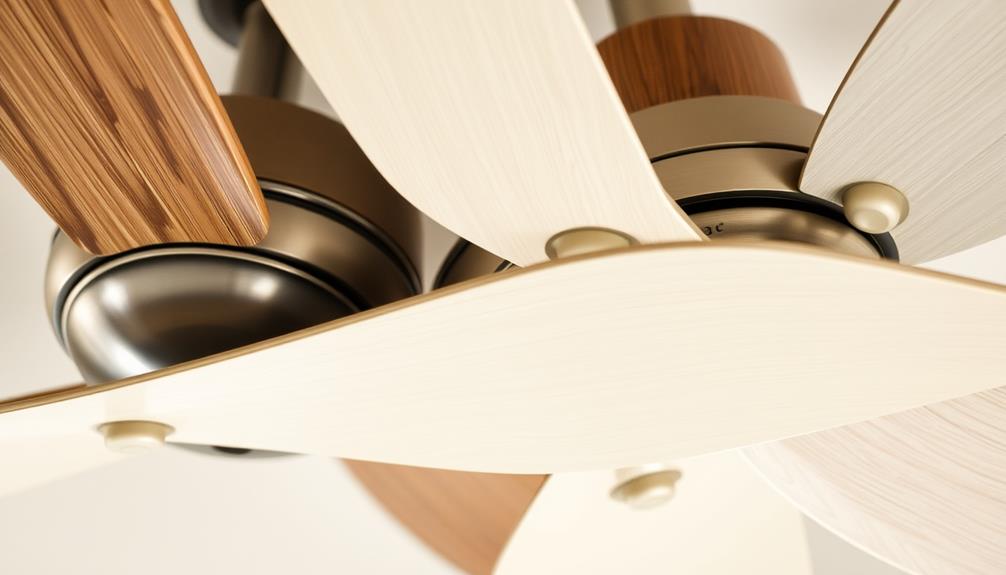
Ceiling fan blades serve one primary function: to circulate air throughout a room, creating a rejuvenating cooling effect. When you turn on your ceiling fan, those blades start spinning, pushing air downwards and promoting a pleasant breeze.
The size, shape, and pitch of the blades play a crucial role in how effectively they move air. Larger blades can push more air, while the angle of the pitch determines how efficiently your fan operates.
To keep your ceiling fan performing at its best, regular maintenance is key. Cleaning dust off the blades and checking for any damage guarantees ideal airflow.
Understanding these elements not only enhances your comfort but also helps you choose the right fan for your space.
Impact of Blade Materials
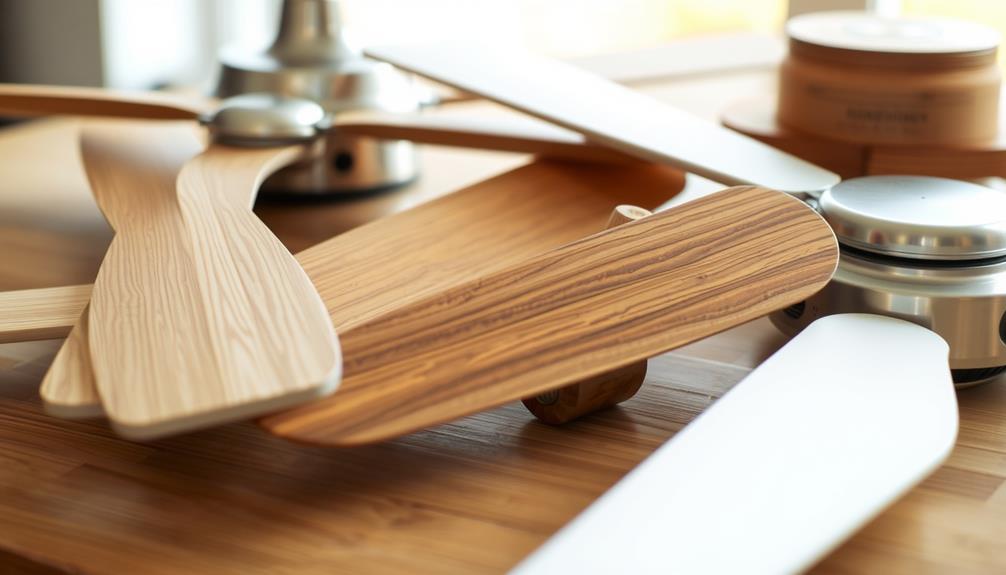
When selecting ceiling fan blades, the material plays a significant role in performance and aesthetics. You've got several options: wood, metal, and composite.
Wood blades deliver a classic look but can warp over time, requiring care.
Metal blades, like aluminum and steel, offer durability and moisture resistance, making them ideal for humid areas.
Composite blades strike a balance, providing versatility and good performance without the maintenance demands of wood.
Think about your room's style and the airflow efficiency each material offers. The right choice can enhance both the fan's functionality and the overall ambiance of your space, so weigh the pros and cons carefully to find what suits your needs best.
Understanding Blade Design
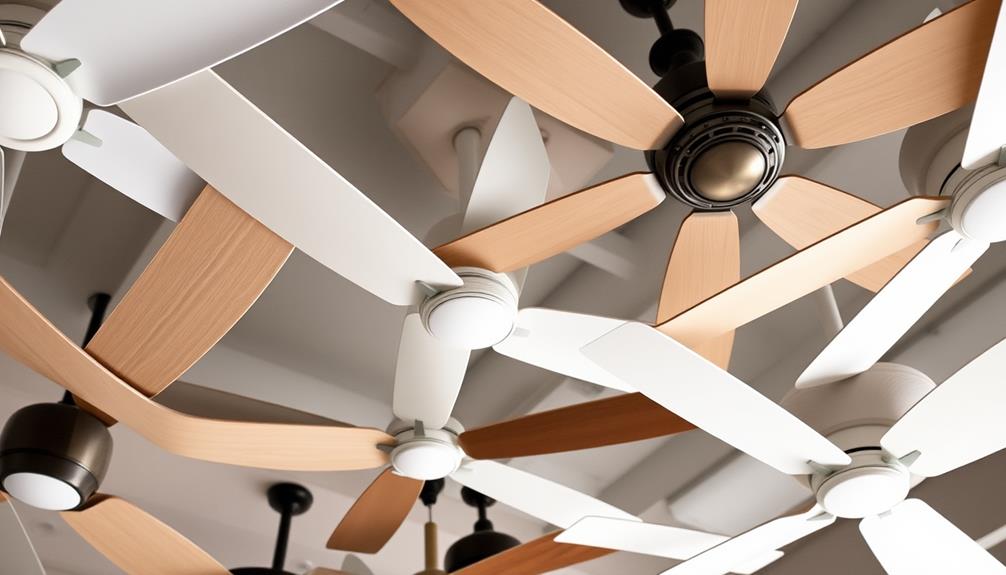
Blade design plays an essential role in a ceiling fan's performance, influencing both airflow efficiency and aesthetic appeal. When choosing a ceiling fan, consider the blade shape, length, and overall design.
Curved blades generally create better airflow than flat ones, while longer blades can move more air, making them ideal for larger spaces. Additionally, modern Energy Star certified fans can enhance airflow and potentially lower energy bills, contributing to energy savings and comfort.
The number of blades also matters; more blades can provide a different aesthetic and airflow experience. Remember, the materials used for the blades will impact both durability and maintenance.
A well-designed blade not only optimizes air circulation but also enhances the room's overall look. Understanding these design elements will help you make an informed decision for your ceiling fan needs.
Importance of Blade Pitch
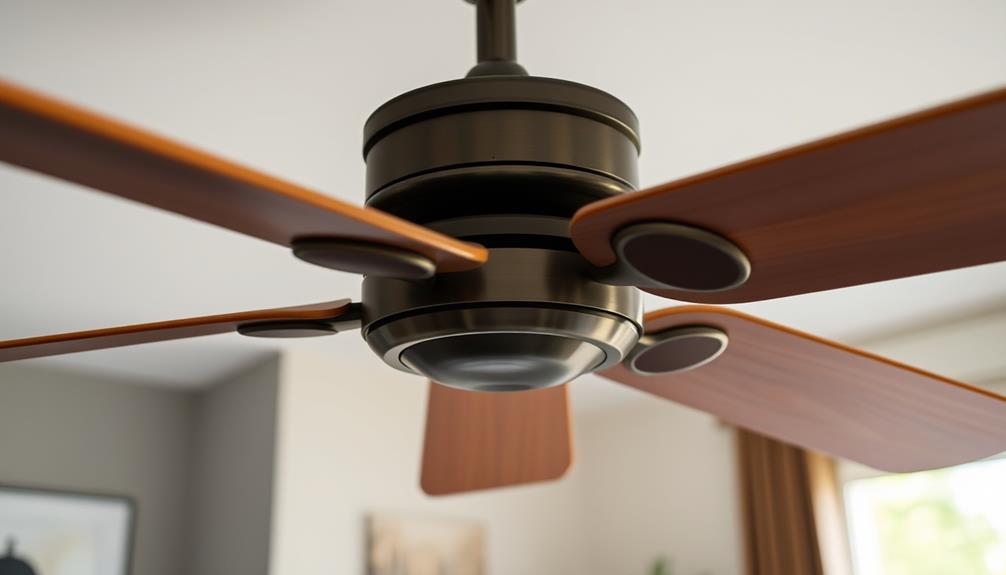
The angle of the blades, known as pitch, is essential for maximizing airflow and cooling efficiency in your ceiling fan. A steeper pitch enhances air movement, which means better circulation and cooling for your space.
Here are four key points about blade pitch you should consider:
- Typical Range: Most residential fans feature a pitch between 10 and 15 degrees.
- Customizable Options: Some fans offer adjustable pitches, allowing you to tailor airflow to your needs.
- Impact on Airflow: A larger pitch can markedly increase the amount of air moved per rotation.
- Blade Shape Matters: Curved blades with steep pitches often outperform flat blades in airflow efficiency.
Understanding blade pitch helps you choose a fan that meets your cooling requirements effectively.
Noise Reduction Strategies

Many homeowners overlook the importance of noise reduction strategies when selecting ceiling fans, yet it's an essential aspect that can enhance your overall comfort.
To minimize noise, consider choosing fan blades made from composite materials, as they effectively dampen sound. Aerodynamic blade designs also play a significant role; they reduce turbulence and the noise associated with it.
Additionally, always guarantee proper weight distribution across fan blades to prevent wobbling, which can create unwanted sounds. Regularly checking and adjusting blade pitch can optimize airflow and further reduce noise levels.
Maintenance Best Practices
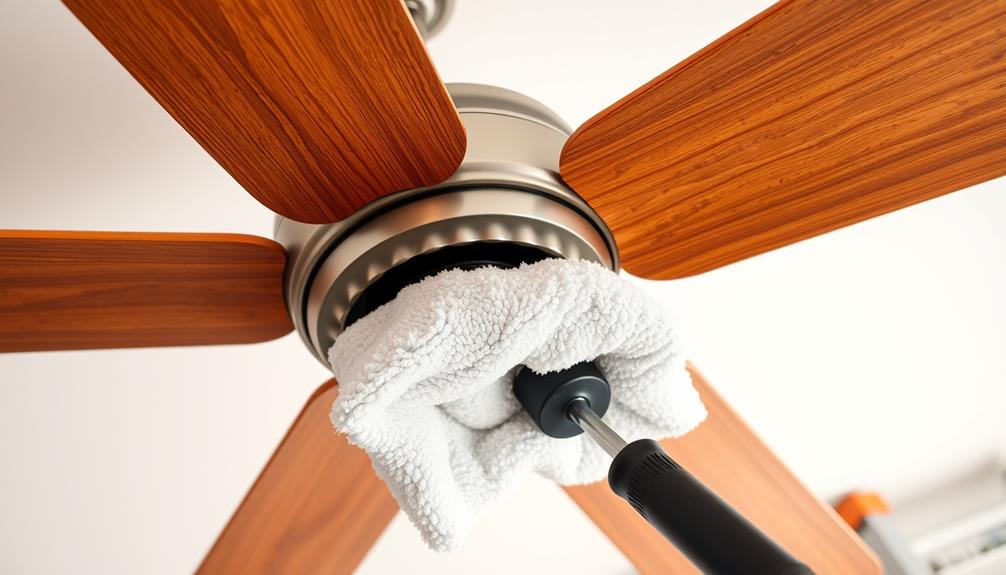
To keep your ceiling fan running efficiently and quietly, regular maintenance is key.
By following these best practices, you'll guarantee peak performance and longevity:
- Dust Regularly: Wipe the blades with a damp cloth to prevent dust buildup that can hinder airflow.
- Inspect for Damage: Check for any cracks or warping in the blades. Replace damaged blades promptly to maintain balance.
- Lubricate the Motor: Periodically lubricate the fan motor to reduce friction and noise, guaranteeing smooth operation.
- Balance the Blades: Use a balancing kit if you notice wobbling. Properly balanced blades enhance airflow and reduce noise.
These simple steps can greatly improve your ceiling fan's performance and extend its lifespan.
Upgrading Ceiling Fan Blades
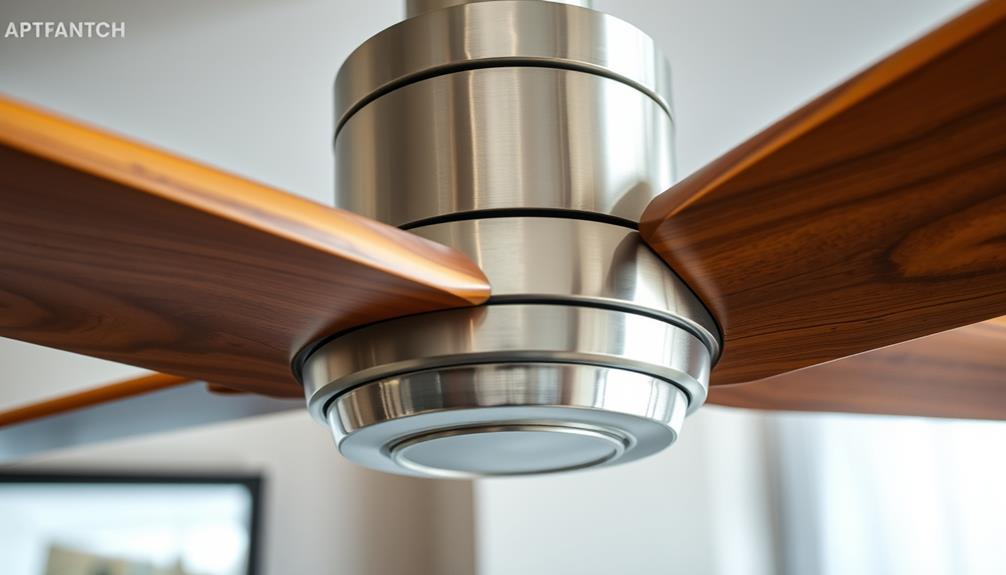
Wondering how you can enhance your ceiling fan's performance? Upgrading your ceiling fan blades can make a significant difference.
Start by ensuring compatibility with your existing fan model; not all blades fit every fan. Consider selecting blades with a steeper pitch, as they improve airflow and cooling efficiency. Wider blades are perfect for larger rooms, generating more circulation.
Think about the materials too; metal blades offer durability, while wooden blades provide a classic look. Don't forget about aesthetics—choose colors and designs that complement your space.
Frequently Asked Questions
How Do Ceiling Fan Blades Affect Energy Efficiency?
Ceiling fan blades greatly impact energy efficiency by influencing airflow and cooling. By selecting blades with ideal pitch and size, you'll enhance air circulation, allowing you to maintain comfort while reducing reliance on air conditioning.
Can I Mix Different Blade Materials on One Fan?
Imagine a painter blending colors on a canvas. You can mix different blade materials on one fan, but make certain they're compatible. This can affect performance and aesthetics, so choose wisely for the best results.
What Are the Optimal Blade Sizes for Small Rooms?
For small rooms, you'll want blade sizes between 40 to 52 inches. These dimensions guarantee adequate air circulation without overwhelming the space, enhancing comfort while maintaining a balanced aesthetic that complements your room's design.
Do Blade Colors Influence Temperature Perception?
Yes, blade colors can influence temperature perception. Darker colors absorb heat, potentially making a room feel warmer, while lighter colors reflect light, helping to create a cooler ambiance. Choosing the right color can enhance your comfort.
How Often Should I Replace Ceiling Fan Blades?
Think of your ceiling fan blades as weary travelers. You should replace them every five to ten years, or sooner if you notice warping or significant wear. Keeping them fresh guarantees peak airflow and comfort in your space.
Conclusion
By mastering the secrets of ceiling fan blades, you're not just enhancing your home; you're transforming it into a breezy paradise! Picture yourself gliding through a whirlwind of cool air, as your perfectly designed blades create a symphony of comfort and style. With the right materials and pitch, your ceiling fan can become the crown jewel of your living space, whispering sweet nothings of tranquility while banishing stuffiness to the darkest corners of your home. Choosing the right fan for your needs is crucial in achieving the ultimate comfort and style in your home. When shopping for a ceiling fan, consider factors such as the size of the room, the ceiling height, and the design aesthetic you want to achieve. By carefully selecting a fan that suits your specific requirements, you can elevate your living space to new levels of relaxation and luxury. When you find the perfect ceiling fan for your home, it’s like discovering the preferred destination port for a smooth sailing journey. The right fan will not only provide comfort and style, but it will also enhance the overall atmosphere of your living space. Whether you’re looking for a sleek and modern design or a more traditional and elegant aesthetic, the ceiling fan you choose can serve as the perfect centerpiece for your home.
